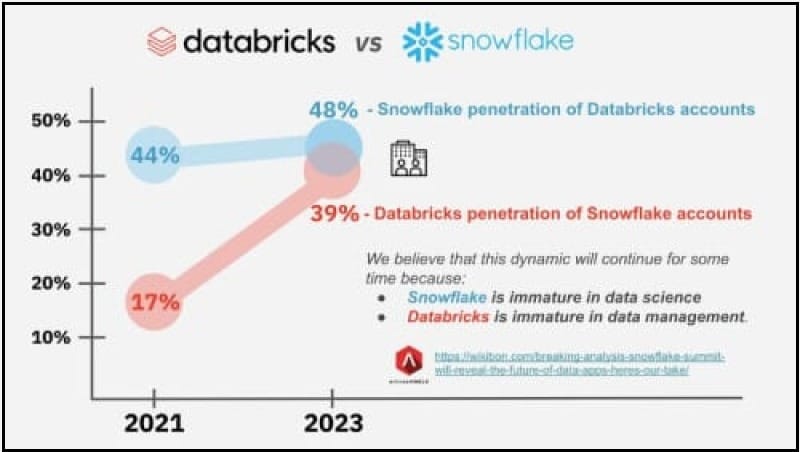Community Comment: Part 33 - With respect to Databricks vs Snowflake, actual usage is more interesting than account creation
- Snowflake vs Databricks account penetration
- Account growth rates not divulged
- Data can be easily misinterpreted
- Databricks: AI advantage, closing in elsewhere
The comments I provided in reaction to a community discussion thread.
Strategic Data & AI Advisor at Databricks:
I always tell customers, if snowflake is able to justify their expensive premium, use them. Databricks Lakehouse Federation in Unity Catalog unifies data wherever it is stored. We also have economical warehouse compute that is competitive if their premium is unjustified.
Use what makes sense for the use case.
Head of Product at Data Lakehouse Product Firm:
The most common questions I received in comments and DMs from my previous post about how often both Snowflake ❄ and Databricks 🧱 are used together were:
(https://lnkd.in/gwhGZu5g)
❓ – "Is this overlap growing or declining?"
❓ – "Why would someone use both Snowflake and Databricks?"
Don't worry, the folks at SiliconAngle have the answers again. In this other report they breakdown the trends of ETR data showing penetration growth from 2021 -> 2023 🤯:
https://lnkd.in/gp6W4dT5
💡 If you find this kind of analysis useful, then you probably want to take a peek at the whitepaper our team recently put together. It's a lengthy read full of research and experience compiled from great sources like above:
👉 https://lnkd.in/g3skAJn2 👈
#databricks #snowflake #onetable #apachespark #datascience #datalakehoue #datawarehouse #dataintelligenceplatform

Gfesser:
About the Databricks versus Snowflake accounts penetration graph posted here: keep in mind that this doesn't really show account growth rates across these two during this two year time period. It would be additionally insightful to show what this breakdown looks like for both the blue and red lines. Also worth pointing out is that this graph might be misinterpreted to mean that accounts for one product were always expanded to include the other product, but it's likely that in a fair number of cases one product actually replaced (or is in the process of replacing) the other.
Strategic Data & AI Advisor at Databricks:
Everyone needed a warehouse, but not everyone does data science, Im pretty sure those snowflakes joke that Machine Learning is just nested case/if statements. Nowadays everyone wants to do AI. Databricks is just catching up. The next 5 years will be interesting. Should be fun. 🤓
Gfesser:
[Strategic Data & AI Advisor at Databricks] just to leave no room for misinterpretation, Databricks isn't catching up with AI (since it's already far ahead)…it's catching up with Snowflake's initial warehouse advantage.
Chief Data Scientist at UK Based Consultancy:
When it comes to data context is everything.
Snowflake has more than double the penetration of databricks currently. Thus as a relative percentage you'd expect more penetration from databricks into snowflake
Gfesser:
[Chief Data Scientist at UK Based Consultancy] yes, context is important. I mentioned in my earlier comment that additionally breaking down this graph by growth rate (e.g. by number of accounts) would provide more insight behind this one-dimensional plot. An aspect that would likely provide even more relevance is the extent to which each account is actually being used (i.e. usage is arguably more interesting than account creation). All of this said, however, it doesn't seem logical to me that a greater number of overall Snowflake accounts would lead to an increased percentage of Snowflake accounts introducing Databricks. In reviewing this discussion in Dave's article, it would seem that the reverse would be true, with the given presumption that the number of Databricks accounts is smaller.